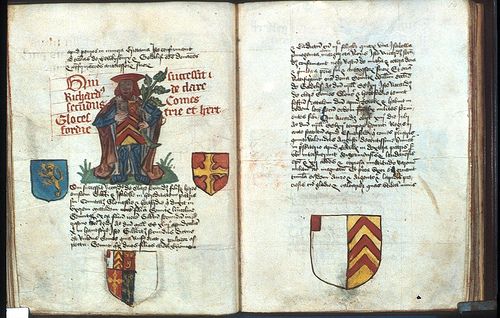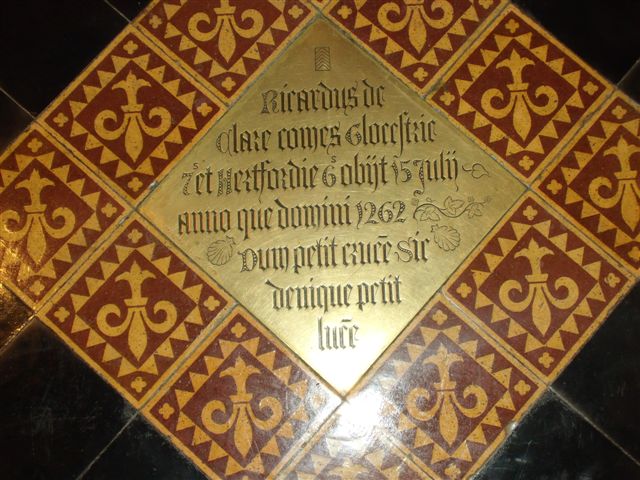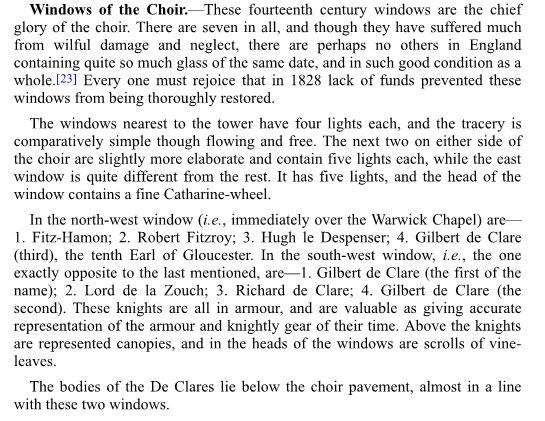A year after he became of age, he was in an expedition against the Welsh. Through his mother, he inherited a fifth part of the Marshal estates, including Kilkenny and other lordships in Ireland.
He joined in the Barons' letter to the Pope in 1246 against the exactions of the Curia in England. He was among those in opposition to the King's half-brothers, who in 1247 visited England, where they were very unpopular, but afterwards he was reconciled to them.
On April 1248, he had letters of protection for going over seas on a pilgrimage. At Christmas 1248, he kept his Court with great splendor on the Welsh border. In the next year he went on a pilgrimage to St. Edmund at Pontigny, returning in June. In 1252 he observed Easter at Tewkesbury, and then went across the seas to restore the honor of his brother William, who had been badly worsted in a tournament and had lost all his arms and horses. The Earl is said to have succeeded in recovering all, and to have returned home with great credit, and in September he was present at the Round Table tournament at Walden.
In August 1252/3 the King crossed over to Gascony with his army, and to his great indignation the Earl refused to accompany him and went to Ireland instead. In August 1255 he and John Maunsel were sent to Edinburgh by the King to find out the truth regarding reports which had reached the King that his son-in-law, Alexander, King of Scotland, was being coerced by Robert de Roos and John Baliol. If possible, they were to bring the young King and Queen to him. The Earl and his companion, pretending to be the two of Roos's knights, obtained entry to Edinburgh Castle, and gradually introduced their attendants, so that they had a force sufficient for their defense. They gained access to the Scottish Queen, who made her complaints to them that she and her husband had been kept apart. They threatened Roos with dire punishments, so that he promised to go to the King.
Meanwhile the Scottish magnates, indignant at their castle of Edinburgh's being in English hands, proposed to besiege it, but they desisted when they found they would be besieging their King and Queen. The King of Scotland apparently traveled South with the Earl, for on September 24 they were with King Henry III at Newminster, Northumberland. In July 1258 he fell ill, being poisoned with his brother William, as it was supposed, by his steward, Walter de Scotenay. He recovered but his brother died
Richard died at John de Griol's manor of Asbenfield in Waltham, near Canterbury, July 14, 1262, it being rumored that he had been poisoned at the table of Piers of Savoy. On the following Monday he was carried to Canterbury where a mass for the dead was sung, after which his body was taken to the canon's church at Tonbridge and interred in the choir. Thence it was taken to Tewkesbury Abbey and buried July 28, 1262, with great solemnity in the presence bishops and eight abbots in the presbytery at his father's right hand.
Richard's own arms were: Or, three chevronels gules
By his second wife, Maud de Lacy, daughter of the Surety John de Lacy and Margaret Quincy, he had:
Isabel de Clare, b. ca. 1240, d. 1270, m. William VII of Montferrat.
Gilbert de Clare, b. 2 September 1243, d. 7 December 1295, 6th Earl of Hertford, 7th Earl of Gloucester.
Thomas de Clare, b. ca. 1245, d. 1287, he seized control of Thomond in 1277.
Bogo de Clare, b. ca. 1248, d. 1294.
Margaret de Clare, b. ca. 1250, d. 1312, m. Edmund, 2nd Earl of Cornwall
Rohese de Clare, b. ca. 1252, m. Roger de Mowbray
Eglentina, d. 1257 in infancy.
His widow Maud, who had the manor of Clare and the manor and castle of Usk and other lands for her dower, erected a splendid tomb for her late husband at Tewkesbury. She arranged for the marriages of her children. She died before March 10, 1288.
A year after he became of age, he was in an expedition against the Welsh. Through his mother, he inherited a fifth part of the Marshal estates, including Kilkenny and other lordships in Ireland.
He joined in the Barons' letter to the Pope in 1246 against the exactions of the Curia in England. He was among those in opposition to the King's half-brothers, who in 1247 visited England, where they were very unpopular, but afterwards he was reconciled to them.
On April 1248, he had letters of protection for going over seas on a pilgrimage. At Christmas 1248, he kept his Court with great splendor on the Welsh border. In the next year he went on a pilgrimage to St. Edmund at Pontigny, returning in June. In 1252 he observed Easter at Tewkesbury, and then went across the seas to restore the honor of his brother William, who had been badly worsted in a tournament and had lost all his arms and horses. The Earl is said to have succeeded in recovering all, and to have returned home with great credit, and in September he was present at the Round Table tournament at Walden.
In August 1252/3 the King crossed over to Gascony with his army, and to his great indignation the Earl refused to accompany him and went to Ireland instead. In August 1255 he and John Maunsel were sent to Edinburgh by the King to find out the truth regarding reports which had reached the King that his son-in-law, Alexander, King of Scotland, was being coerced by Robert de Roos and John Baliol. If possible, they were to bring the young King and Queen to him. The Earl and his companion, pretending to be the two of Roos's knights, obtained entry to Edinburgh Castle, and gradually introduced their attendants, so that they had a force sufficient for their defense. They gained access to the Scottish Queen, who made her complaints to them that she and her husband had been kept apart. They threatened Roos with dire punishments, so that he promised to go to the King.
Meanwhile the Scottish magnates, indignant at their castle of Edinburgh's being in English hands, proposed to besiege it, but they desisted when they found they would be besieging their King and Queen. The King of Scotland apparently traveled South with the Earl, for on September 24 they were with King Henry III at Newminster, Northumberland. In July 1258 he fell ill, being poisoned with his brother William, as it was supposed, by his steward, Walter de Scotenay. He recovered but his brother died
Richard died at John de Griol's manor of Asbenfield in Waltham, near Canterbury, July 14, 1262, it being rumored that he had been poisoned at the table of Piers of Savoy. On the following Monday he was carried to Canterbury where a mass for the dead was sung, after which his body was taken to the canon's church at Tonbridge and interred in the choir. Thence it was taken to Tewkesbury Abbey and buried July 28, 1262, with great solemnity in the presence bishops and eight abbots in the presbytery at his father's right hand.
Richard's own arms were: Or, three chevronels gules
By his second wife, Maud de Lacy, daughter of the Surety John de Lacy and Margaret Quincy, he had:
Isabel de Clare, b. ca. 1240, d. 1270, m. William VII of Montferrat.
Gilbert de Clare, b. 2 September 1243, d. 7 December 1295, 6th Earl of Hertford, 7th Earl of Gloucester.
Thomas de Clare, b. ca. 1245, d. 1287, he seized control of Thomond in 1277.
Bogo de Clare, b. ca. 1248, d. 1294.
Margaret de Clare, b. ca. 1250, d. 1312, m. Edmund, 2nd Earl of Cornwall
Rohese de Clare, b. ca. 1252, m. Roger de Mowbray
Eglentina, d. 1257 in infancy.
His widow Maud, who had the manor of Clare and the manor and castle of Usk and other lands for her dower, erected a splendid tomb for her late husband at Tewkesbury. She arranged for the marriages of her children. She died before March 10, 1288.
Family Members
Advertisement
Explore more
Sponsored by Ancestry
Advertisement










